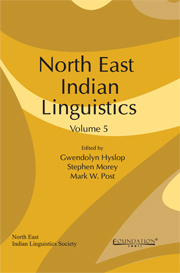Book contents
- Frontmatter
- Contents
- About the Contributors
- Foreword
- A Note from the Editors
- Contact and genetic linguistics
- Historical-comparative Tibeto-Burman grammar
- The North East Indian noun phrase
- Assamese grammar
- 9 Reciprocal constructions in Asamiya
- 10 Question formation in Asamiya (Assamese)
- Advances in Boro-Garo phonology
- Poetics and text
9 - Reciprocal constructions in Asamiya
from Assamese grammar
Published online by Cambridge University Press: 05 September 2013
- Frontmatter
- Contents
- About the Contributors
- Foreword
- A Note from the Editors
- Contact and genetic linguistics
- Historical-comparative Tibeto-Burman grammar
- The North East Indian noun phrase
- Assamese grammar
- 9 Reciprocal constructions in Asamiya
- 10 Question formation in Asamiya (Assamese)
- Advances in Boro-Garo phonology
- Poetics and text
Summary
Introduction
The term reciprocal construction refers to specialized patterns used in languages to encode reciprocity. Reciprocity is understood as: (a) a kind of symmetrical situation between two mutuants, i.e., participants or arguments, that are engaged in a mutual situation, where (b) the relation between the mutuants A and B is the same as that between B and A (Haspelmath 2007: 2087; Lichtenberk 1985: 21). Put differently, a reciprocal construction encodes a mutual relationship between at least two non-identical participants simultaneously engaged in an identical situation. Some of the most widespread reciprocal strategies which get conventionalized in grammars are affixes, pronouns and clitics (Nedjalkov 2007: 102). Cross-linguistically, the pronominal reciprocal is the most common among syntactic reciprocals, while affixes are one of the important types of morphological devices, and clitics fall into an intermediate position between the two (Nedjalkov 2007: 102). Apart from syntactic and morphological reciprocal strategies, languages may have lexical reciprocal, which is to say lexical words with inherent reciprocal meanings; such words are used for denoting mutual configurations by themselves, and need not occur in a special grammatical construction (Haspelmath 2007; Knjazev 2007).
This chapter presents a descriptive analysis of the various strategies employed in Asamiya (Assamese) for encoding reciprocity in mono-clausal constructions. It is organized into five sections: following this Introduction, §2 is a brief overview of Asamiya.
- Type
- Chapter
- Information
- North East Indian Linguistics , pp. 213 - 233Publisher: Foundation BooksPrint publication year: 2013



